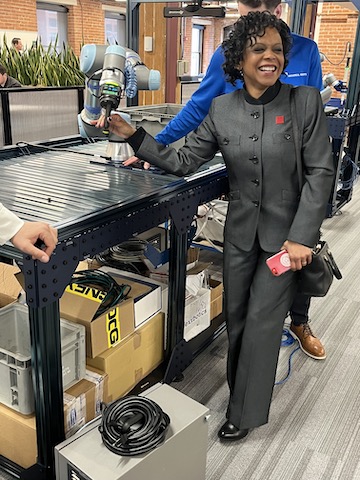Department(s):
The Business School 
When I came to WPI for graduate school in 1985, I gave little thought to the fact that I was one of only a few women and the only African American in my management program. I was accustomed to that dynamic as a software engineer working in the Final Assembly and Test operation for Digital Equipment Corporation. I was one of two women in my group and the only African American. When I returned for a second graduate degree in 1996, I was similarly unfazed. This time, I was studying manufacturing engineering and rationalized that few women were interested in such a course of study. Fast forward to the present. I had the privilege of greeting one of our business classes, Engineering Economics, to welcome our students to D Term. I knew that there were about 40 students in the class, and I expected that approximately 30% of the students would be women. But on this particular day, I was greeted by a class that was almost all male. I knew that several students were absent; nevertheless, I remember being shocked. I understood male dominated classrooms in 1985. I accepted the lack of females in majors that were historically male dominated in 1996. But in 2023, as we celebrate Women’s History Month, I could no longer look beyond the gender disparity.
Why is it that women remain underrepresented in STEM? I believe that societal messaging continues to act as a deterrent. Depending on the discipline, it is not uncommon to see men associated with certain STEM jobs rather than women. Even when males and females are depicted, men will often be featured in the foreground with women taking secondary roles. Thankfully this trend is changing, but the old images and stereotypes remain leaving a negative impact in the wake. I experienced this firsthand as I attended career day at a local elementary school. At the ages of eleven and twelve, I would not have expected established career choices from the sixth graders I met. Notwithstanding, I heard distinct differences between the career choices expressed by girls versus boys. More girls were undecided in their career choices than the boys. However, for the children with expressed vocational aspirations, more boys listed technical careers while girls desired service industry careers. I could not help but wonder why. Are we giving gender-coded messages to our children? Are girls being encouraged to pursue helping roles while boys are encouraged to pursue technology?
And for our girls who desire STEM studies, are we creating pathways to promote their education? WPI has several precollegiate programs to encourage girls to engage in STEM fieldslike “Girls Talk Math” and “Girls Who Code.” We have also engaged in recruitment and retention efforts to bring women to WPI. Our strategies helped us reach an incoming class of students that was 43% female in 2021. But without such focus, those numbers regressed, as they did in 2022 when our first-year class of female students dropped to 31%. The point remains, when we encourage our women and girls, they pursue STEM. And if we intentionally expand their paths, we will see greater parity.
We must also provide supports to retain women in STEM careers. A study conducted by the American Association of University Women (AAUW) indicated that more than half of women scientists, engineers, and technologist in business and high-tech industry quit their jobs by midcareer. The report noted that women experienced feelings of isolation, unsupportive work environments, bias, and disparate gendered roles that made it difficult to balance work and family responsibilities. I saw this in my career as female colleagues left STEM-based positions to start families, never to return. The long hours and challenging environments made it difficult to remain in their jobs. Without strategies that make female retention a priority, industry will continue to see the same unacceptable levels of attrition.
My career has spanned nearly 40 years, and my experiences demonstrate that we still have work to do to encourage women to pursue and remain in STEM fields. It starts by addressing the stereotypes that silently discourage girls from pursuing certain fields. Then, we need to help overcome the confidence gaps that causes girls set their sights lower than their male counterparts. This includes encouraging girls to enroll in math and science classes at early ages. As I told the sixth graders with whom I met, their choices in sixth grade will determine whether they are ready for calculus and physics in college. Those students may not have thought they were making life choices at such a tender age, but by opting for a less rigorous course of study, they may struggle in a school like WPI. And once those young women come to our colleges and universities, we need to make the environments welcoming. Representation matters because its hard to be what you cannot see. But so too does inclusive and respectful environments where every student feels supported and safe. Such advocacy must continue in the workplace so that women realize equity in pay, flexibility in family and leave policies, and inclusivity in their environments. If we would do these things, perhaps we might see the parity that has been elusive thus far in my career.
Blessings,
Debora